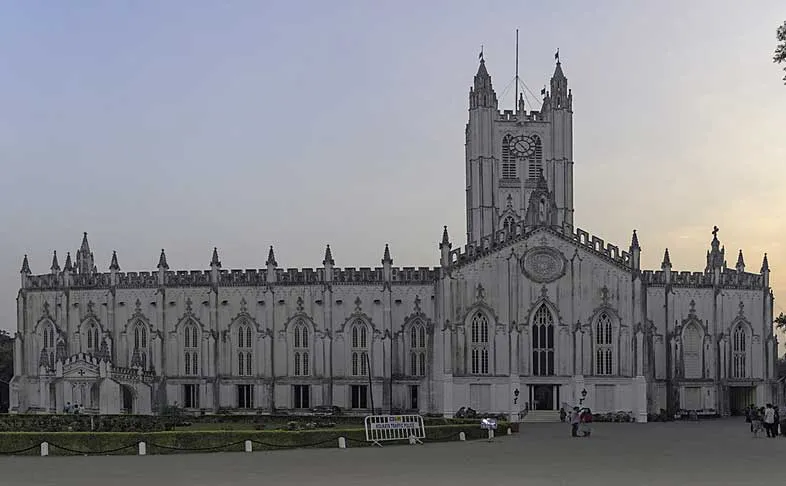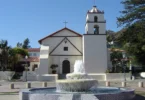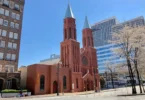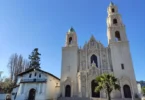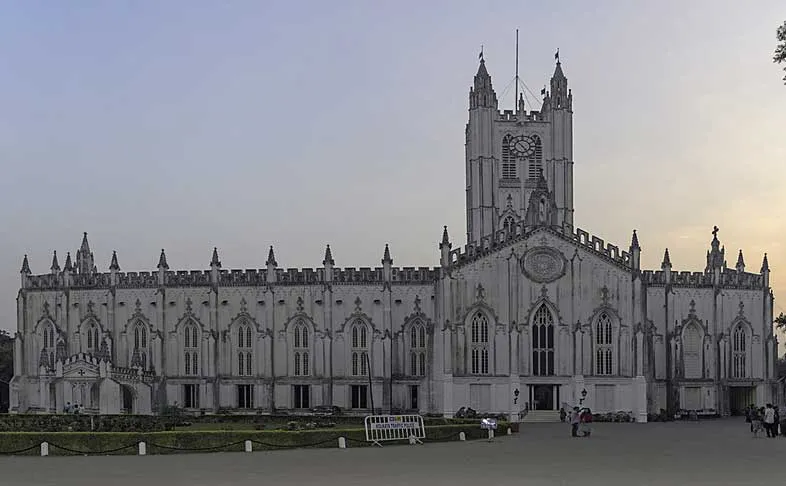
Introduction
St. Paul’s Cathedral is a Church of North India (CNI) cathedral of Anglican background in Kolkata, West Bengal, India, noted for its Gothic architecture and dedicated to Paul the Apostle. It is the seat of the Diocese of Calcutta. The cornerstone was laid in 1839; the building was completed in 1847.
It is said to be the largest church in Kolkata and the first Anglican cathedral in Asia. It was also the first new-built cathedral in the overseas territory of the British Empire. The edifice stands on Cathedral Road on the “island of attractions” to provide for more space for the growing population of the European community in Calcutta in the 1800s.
The architectural design of the cathedral is “Indo-Gothic”, a Gothic architectural style designed to meet the climate of India. Following the 1897 earthquake and the subsequent massive earthquake of 1934, when Calcutta suffered substantial damage, the cathedral was reconstructed to a revised design. The cathedral complex has a library, situated over the western porch, and a display of plastic art forms and memorabilia.
One of the finest colonial buildings in the country, Kolkata’s St Paul’s Cathedral attracts thousands of history buffs every day. Designed by William Nairn Forbes, a graduate of East India Company’s Military school of Addiscombe, the Indo-gothic structure built in 1847 contains myriad historical stories under its roof. The dedicatory tablets, memorials, statues, artefacts, paintings and priceless documents chronicle many unknown or little-known chapters of our heritage.
Apart from that of Bishop Daniel Wilson, the founder of the cathedral, the other notable burial in the church is that of John Paxton Norman, an acting Chief Justice who was assassinated on the steps of Kolkata Town Hall in 1871.
The cathedral is across from the Bishop’s House at 51, Chowringhee Road, in a direct line of sight from the Victoria Memorial. The cathedral is located to the east of the Victoria Memorial and at the southern edge of the maidan, the largest open space in the city.
The building stands on Cathedral Road, on the “island of attractions” in Kolkata, along with the Victoria Memorial, Nandan, Rabindra Sadan theatre complex and the Birla Planetarium.
History of St. Paul's Cathedral, Kolkata
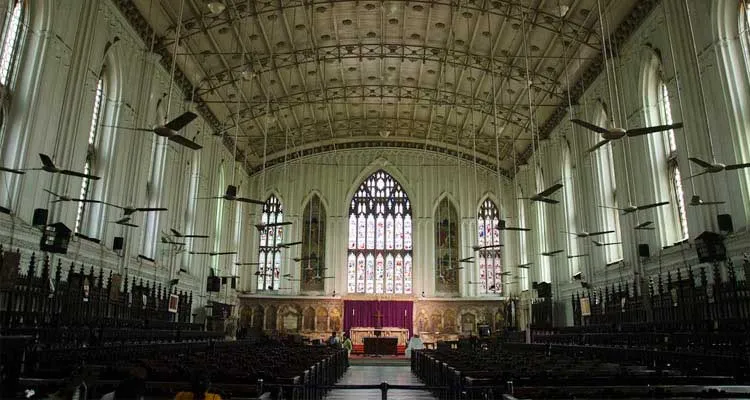
The cathedral was built to replace St. John’s Church, which had become too small for Calcutta’s growing European community; by 1810 there were 4,000 British men and 300 British women in Bengal.
In 1819, at the request of Francis Rawdon-Hastings, 1st Marquess of Hastings – then Governor-General of Bengal – Royal Engineers officer William Nairn Forbes produced a design for the proposed cathedral; however, it was not accepted as it was deemed too expensive to build.
Bishop Middleton suggested as a site for the new cathedral the part of the city now known as “Fives Court”, where the cathedral now stands. In 1762 the area had been described as a forest so wild that it harbored tigers and at first it was regarded as “too far south” to serve as a location for the cathedral. Middleton died in 1822 before building plans took shape. The next three bishops – Reginald Heber, Thomas James and John Turner – all died after brief tenures, and it was not until 1832, under Bishop Daniel Wilson, that the project to build the cathedral was revived.
Following acquisition of 7 acres (3 ha) of land to build the cathedral, a Cathedral Committee was set up to build it. The military engineer, Major William Nairn Forbes (1796–1855) (who later became a Major-General in the Bengal Engineers), at the request of Bishop Wilson, designed the cathedral with the assistance of architect C. K. Robinson, modelling the tower and spire on Norwich Cathedral. On 8 October 1839, construction was initiated by laying the cornerstone. The cathedral was completed after eight years and consecrated on 8 October 1847.
The consecration ceremony, to mark which Queen Victoria had sent “ten pieces of silver-gilt plate” for the cathedral, was largely attended by Europeans and local people. The cathedral was built in Gothic revival style, but with modern construction elements, including an iron framework. It was built with a chancel, a sanctuary, chapels and a 201 feet (61 m) tall spire; the cost of construction of the edifice was then Rs. 4,35,669. The cathedral can accommodate 800 to 1,000 people.
In the 1897 earthquake the cathedral suffered damage and was refurbished. In the subsequent massive earthquake of 1934, when Calcutta was devastated, the cathedral’s steeple tower collapsed. It was reconstructed to a revised design. Following the 1934 Calcutta earthquake, the tower was rebuilt along the lines of the central Bell Harry tower of Canterbury Cathedral. On its completion, St. Paul’s replaced St. John’s Church as the cathedral.
The cathedral also has a statue of Bishop Heber (1783–1826), Second Bishop of Calcutta; the statue was sculpted by Francis Leggatt Chantrey. The Bishop’s House across the street is also architecturally notable. The cathedral is well maintained in a serene and peaceful atmosphere. People of all religious denominations can visit the church. Service is held regularly. Christmas is a special occasion when a large number of people assemble to participate in the festivities.
Architecture of St. Paul's Cathedral, Kolkata
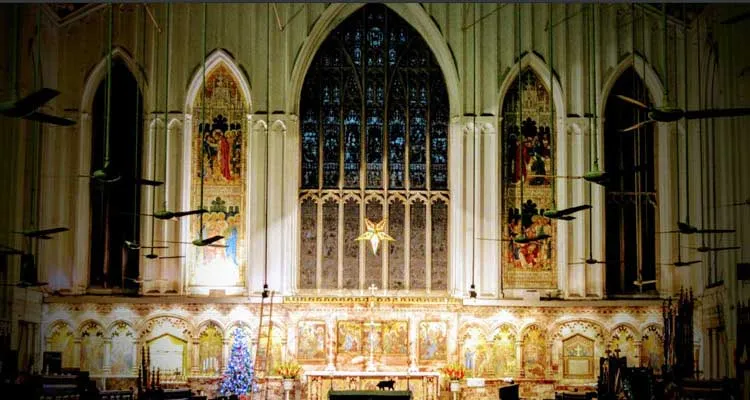
The Imperial Gazetteer defined the architectural design of the cathedral as “Indo-Gothic”, to mean a Gothic architectural style built to meet the climatic conditions of India. It was also called a “spurious gothic adapted to the exigencies of the Indian climate.” The cathedral’s design, otherwise known as Gothic Revival style, includes three stained-glass windows and two frescoes in the Florentine Renaissance style; the West Window was created by Morris & Co. to a design by Sir Edward Burne-Jones.
The nave of the cathedral is very long at 247 feet (75 m), and its width is 81 feet (25 m). The nave is fitted with well-crafted wooden pews and chairs. The central spire rises to a height of 201 feet (61 m), and the tower on which it stands is square in shape and was patterned on the lines of the 12th-century Canterbury Cathedral, England.
The tower was fitted with five clocks, each of which weighed about three tons. The stained-glass windows on the western side were the creation of Sir Edward Burne-Jones, a pre-Raphaelite master, which were fitted in half-sunk arches; these were designed in 1880 in memory of Lord Mayo who was assassinated in the Andaman Islands.
When completed in 1847, the cathedral as a whole was compared to Norwich Cathedral in England. The East window, which had original stained glass, was destroyed by a cyclone in 1964. It was replaced with a new one in 1968. The roof of the cathedral (it was the largest span when built) is in the shape of a shallow curve arching over iron trusses decorated with Gothic tracery.
The nave of the cathedral is built spaciously without any aisles on its flanks. The materials used in the construction of the cathedral consisted of special bricks, light in weight and with good compression strength. The ashlars used were of Chunar stone. The external and internal surfaces of the cathedral were plastered with fine chunam (lime plaster) in the form of stucco.
The cathedral’s interior has a display of many plastic art forms and memorabilia. There is an episcopal throne on the southern flank of the altar and a reredos or decorative wall on its liturgical east end dated to 1879; it has carvings of episodes related to the life of St. Paul, the Annunciation, the Adoration of the Magi, and the Flight into Egypt, all the work of Sir Arthur Blomfield. The parish hall within the premises of the cathedral is the venue for holding social functions.
The eastern wall in the cathedral has paintings of the life of St. Paul, painted by Blomfield in 1886. Also notable is the font, with its sculpture of Bishop Heber in a kneeling posture. The Cathedral housed an organ, with 41 stops, made by Henry Willis and Sons of London. It was dismantled and replaced with a reed organ. Following this, the reed organ was replaced with a 1938 Hammond Model E Organ. Currently, the church has and uses a Viscount Vivace 40, a 2 Manual, 31-stop electric organ. It is played by the present organists, Mr. George Sudeep Pande and Mr. Shreejit Saha.
The cathedral complex also has a library, situated over the western porch, to dimensions of 61 by 22 feet (19 m × 7 m) with a height of 35 feet (11 m). It was built at the initiative of Bishop Wilson, who donated 8,000 of his books and manuscripts. Further donations of books to the library were from W. Gordon and Rev. J. Nath of the University of Oxford and the Calcutta Bible Society. The library also has a sculpture of Bishop Wilson made in marble.
Entry to the cathedral is from the north through a large gate made of wrought iron called the Sir William Prentice Memorial Gate, which is named after Sir William Prentice, who was a member of cathedral’s congregation for many years. The cathedral is surrounded by a well-tended garden. In 1847, 63 species of trees had been planted in this garden.
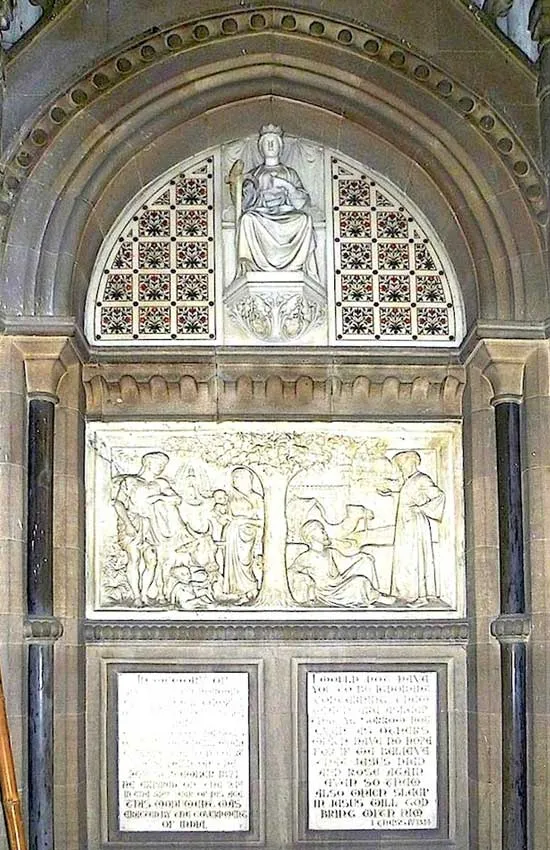
Burials
Bishop Daniel Wilson, who had requested burial in the cathedral and also that memorial tablets be placed at St. Pauls’ Cathedral, in Bishop’s College Chapel at Calcutta, and in the St Mary’s Church, Islington, lies in an underground chamber of the cathedral, where a plaque conferred on him by Queen Victoria is also on display.
Sir John Paxton Norman, an acting Chief Justice who was assassinated, is memorialized by a large, decorated plaque, surmounted by a cross, with an engraving depicting Justice with her scales against a background of tile work flowers evoking Judge Norman’s interest in botany. Arthur William Garnett, an English engineer who died in India in 1861, was buried here.
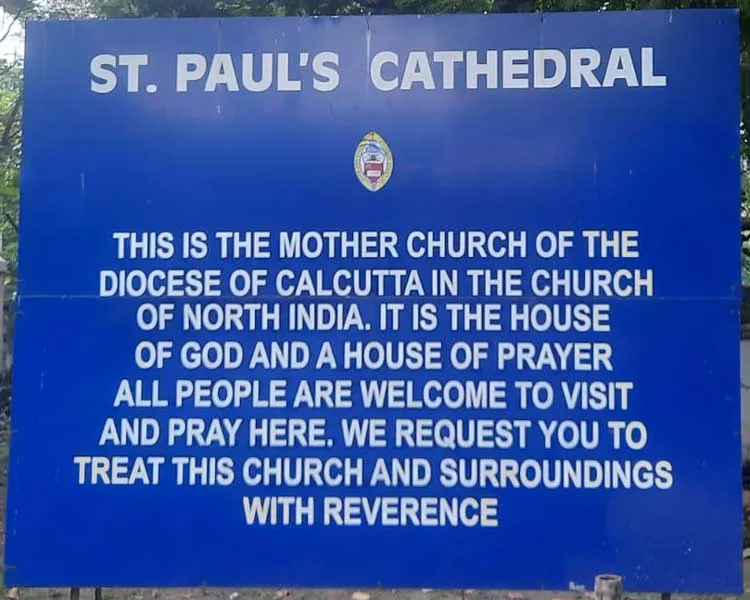
Features of the Cathedral
Originally built in gothic architectural style, the St. Paul’s Cathedral is considered as one of the many architectural marvels of the colonial era. The magnificent structure had undergone quite a few renovations that led to the changes in the original monument. The present structure has Indo- Gothic elements of Gothic Revival architecture to stand the strong tropical climate that Kolkata experiences.
The cathedral was designed by Sir Arthur William Bloomfield of London and bears semblance to the Norwich Cathedral of England.
The cathedral building is built with specially made out bricks that were lighter and at the same time, including great compressional strength that would allow them to withstand extreme temperatures and climatic disasters. Chunar stones have also been used as dressed stones whereas, the interior and exterior of the building was plastered with fine lime plaster, also called chunam, very similar to a stucco.
The interior of the cathedral is one single hall without any side aisles. Its interiors are flanked with unusually high ceiling, beautifully carved pews, murals and paintings on the walls and other pre- independence artefacts including monuments of all bishops.
The sculptures in the church building were designed by some of the finest artists belonging to the cream of British empire. The shallow curves in the roof of the cathedral was designed basically with a doubt whether the ground would be able to support the weight of pillars and heavy arches. Hence, the roof is like a shallow curve having the largest iron span at the time when it was built, spanned by 151 iron trusses.
The cathedral also dons three stained glass windows on its western wall along with frescoes represented in Florentine renaissance classic style. The stained-glass windows were designed by master designer Sir Edward Brune- Jones in the memory of Lord Mayo. The East window also had original stained-glass windows that were destroyed in the 1964 cyclone and were restored in 1968.
Among the paintings on the walls of the cathedral, there are paintings that depict the life and significance of St. Paul including his annunciation, his flight into Egypt and the Adoration of the Magi. All the paintings of St. Paul have been done by Sir Arthur Blomfield.
The cathedral still has the Willis pipe organ with 41 stops, made by Henry Willis & Sons of London. Towards the western porch, there is a library situated in the cathedral premises. Bishop Wilson was the brains behind the idea of a library being set up and he also donated 8000 books and manuscripts which were from his personal collection.
It is surrounded by a very well-maintained garden with over 184,700 species of trees planted till date.
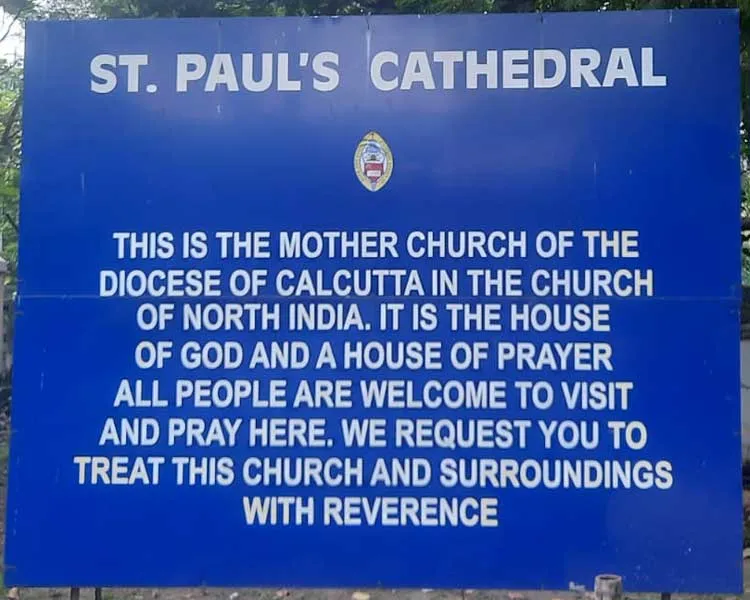
A Lesser Known Chapter of History
Hardly anyone takes notice of a black cross made of two charred log beams placed on the wall with a very dignified display, and the small bust of a man named Canon Subir Biswas near it.
Canon Subir Biswas is not a name that many Kolkatans can recall, but he was a man who took the name of this city across the world and supported people vandalised by a brutal army from West Pakistan. The story of the charred cross of Bangladesh and Canon Subir Biswas, a Bengali priest of St Paul’s Cathedral, was etched in the memory of people from West Bengal and Bangladesh for years but is fading from memory, even within St Paul’s.
Subir Biswas was born on December 17, 1933, to a Bengali Christian family in Delhi. After finishing his education in Kolkata’s La Martiniere for Boys school and St Xavier’s College, he joined Bishop College to pursue working as an ordained priest. After a brief period at the St Thomas Church on Free School Street (Mirza Ghalib Street), he was sent to the Selwyn College in Cambridge to study Greek and Liturgy.
From 1961, he played an important role in many churches, and was finally appointed as Vicar of St Paul’s Cathedral in 1970. He also became Canon of the cathedral. Biswas was involved in many social service projects but the turn of events in March 1971, changed his outlook and role as Canon of one of India’s most important churches.
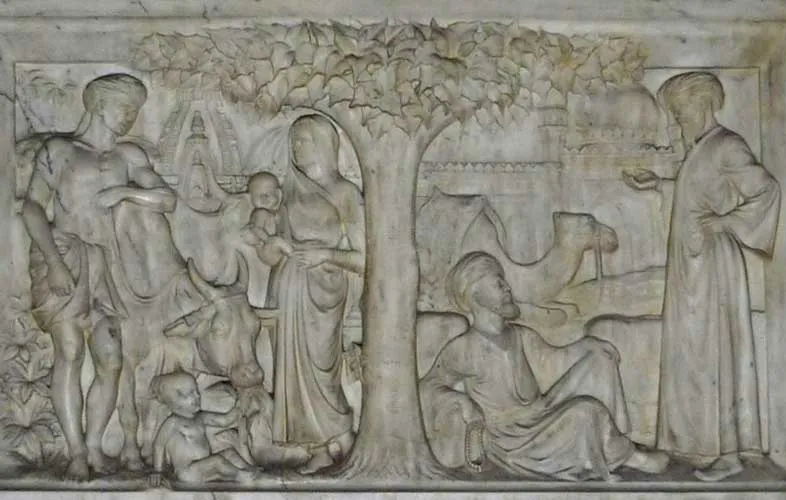
The Battle for Bangladesh
The military oppression of people in East Bengal reached a pinnacle in March 1971 when even after winning majority seats in Parliament, Sheikh Mujibur Rahman was not allowed to take over the country as a democratically elected Prime Minister.
The brutal military operation to suppress people’s war of freedom resulted in large-scale atrocities and an exodus of people, and soon Kolkata and other districts of Bengal saw an influx of refugees. Though the government did its best to provide safe and comfortable shelter, it was inadequate.
Subir Biswas realised that he could offer support to these people and formed an organisation called the Cathedral Relief Service (CRS) to stand beside the refugees of Bangladesh. He applied for funds worldwide and soon consignments of food, medicine, clothing and other relief materials were supplied to various refugee camps across borders. He also opened the gates of the cathedral converting it to a warehouse for relief material. The slogan, ‘Cathedral Belongs to The City’ was coined around this time to establish the church’s role in nation-building.
On December 11, 1971, CRS crossed the border into Bangladesh and during his travels across villages, Biswas witnessed first-hand the devastated battlegrounds.
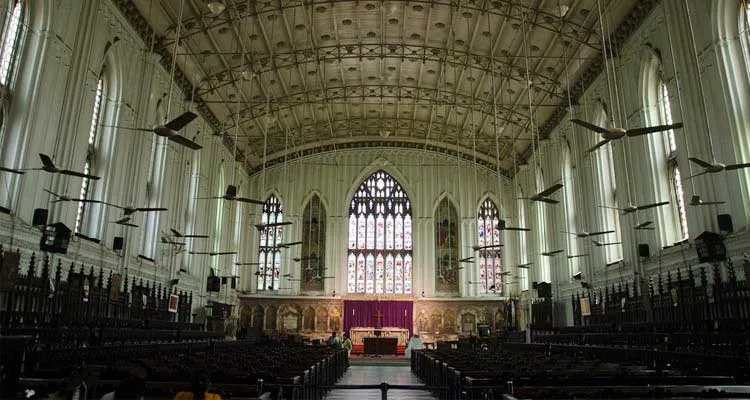
The Charred Cross at St Paul’s Cathedral
Biswas collected charred log beams from the burnt homes in a few villages and on returning to Kolkata made many big and small crosses, raising them as symbols of the sin of men, the forgiveness of god and the mission of the church to rebuild. He sent them to big churches across the globe appealing for aid and contributions for Bangladesh.
In Kolkata, he organised a rally, inviting all other churches and led the procession carrying a cross made of charred logs. His unique initiative attracted a huge response and the funds collected were utilised to repatriate many refugees.
The cross that Canon Subir Biswas carried in Kolkata is the one displayed at St Paul’s Cathedral. The cross still has a latch on one of the beams — evidence that it was once part of a house — and is placed on a simple podium within the chapel. Next to it, on a wall-mounted self is the helmet of an Indian soldier who died in a tank battle, collected from Kushtia district by Canon Biswas on December 13, 1971 — an honour for the Indian army that fought with Bangladesh. Every year on a particular day in December, the Indian army officials come to this corner of the church to pay homage to all soldiers who died in the Bangladesh war.
Above the helmet of the Indian soldier is a small cross belonging to a British soldier, and on the right of the big charred cross a small flame burns in the memory of British soldiers who died in 1914 in France.
Another small cross, collected in December 1971 from a destroyed Roman Catholic church in Ballavpur, finds a place too and as the plaque reads, is displayed as “man’s hate and God’s forgiveness and as a grateful reminder of men and women in this and other lands who made the work of the Cathedral Relief Service possible.”
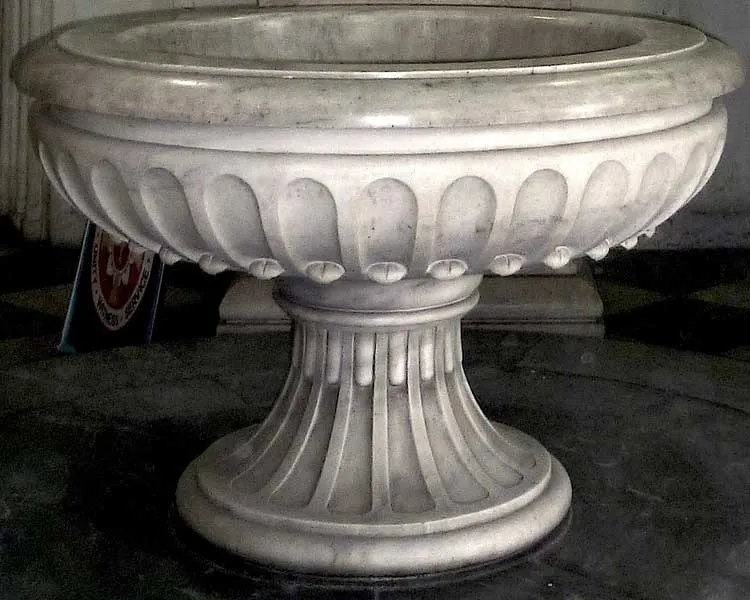
Fittings and Monuments
Bishop Wilson’s full title was “5th Bishop of Calcutta and the 1st Metropolitan” (“St Paul’s Cathedral”), and for this important mother church only the best would do. Among its many beautiful and arresting sights are the east window, designed by Clayton and Bell (a replacement for an earlier one destroyed by a cyclone), the much-admired west window of 1880 designed by Edward Burne-Jones, an alabaster and mosaic reredos of 1879 depicting the Annunciation, Adoration of the Magi, and Flight into Egypt, attributed to Sir Arthur Blomfield.
Mosaic panels of 1886 on the east wall depicting the life of St Paul, also by Blomfield, and a splendid Willis organ. An elegant font, shown above left, stands just in front of the kneeling figure of Bishop Heber, an earlier Bishop of Calcutta. Monuments such as Heber’s contribute greatly to the cathedral’s atmosphere.
Barbara Groseclose writes generally of the sense of “wholeness and completeness” they give, saying of St Paul’s: “the plethora of neo-Gothic frames and settings, enriched here and there with a vague allusion to the inlaid stone common in Mughal decorative art, lends stylistic unity to the interior… and indeed confers cathedral status on it”. The very cream of British designers and sculptors were commissioned to provide these, and there were also local funerary masons, such as Llewellyn and Company, undertakers and stonecutters — the two branches of the funeral trade being commonly combined in the earlier days.
The large and decorative memorial to John Paxton Norman, erected by the government in memory of an assassinated acting Chief Justice, is a fine example of such a monument’s contribution to the cathedral. There had been an outpouring of grief when Judge Norman died: “All the public offices in the city were closed, the standard at Fort William and the flags of the ships in the river hung at half mast, every shop was shut and business entirely suspended”; the case was widely reported in the British papers, too.
As might be expected, an elaborate monument was erected to the judge’s memory. Surmounted by a cross, this shows the figure of justice with her scales seated against a background of tiles inlaid with a bright floral pattern, perhaps alluding to Judge Norman’s love of botany: he was a member of the Botanical Society of London. The relief panel below, instead of showing servile, prostrated or exotic natives, shows Indians going about their everyday lives in peaceful co-existence.
To the left is a Hindu family, with one child feeding a cow, seen against the background of a Hindu temple. To the right are Muslim merchants negotiating or just talking, with a camel and a mosque in the background. Judge Norman was apparently murdered in revenge for what was considered an overly severe punishment, and the monument may seek to convey the fair-mindedness that his friends found in him.
At any rate, the role of justice in the subcontinent is beautifully portrayed here without condescension, and, despite the present context, with respect for the beliefs of the people. Interestingly, Norman, whose main published works were reports of cases brought before the Courts of Exchequer, also wrote a book on copyright in designs, and the copyright and registration of sculpture. This mural monument looks rather like an arched door. It is certainly shows openness to another culture.
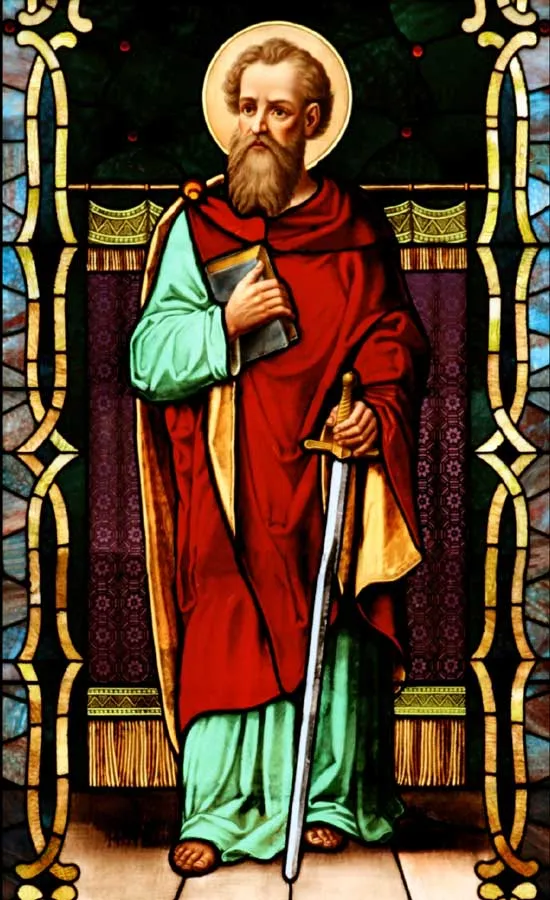
The Consecration
The consecration of St Paul’s on 8 October 1847 was a splendid occasion: “It would have been most gratifying to the Queen’s religious and benevolent heart, could Her Majesty have honoured the Consecration with her presence,” wrote Bishop Wilson wistfully to Queen Victoria. The presence of the Queen would have been too much to hope for, but he was delighted by the turn-out of local people. “Such a sight had never been seen in India.
A crowded audience filled the sacred edifice, pressed around the doors, and in the lantern and transept, to obtain a sight of what was taking place, and hear the Divine Word. The impression made on the minds of the Christian community, and the native population, was electric. I trust a permanent blessing will follow”. The Queen had already presented the bishop with “ten pieces of silver-gilt plate” for “St Paul’s Cathedral”.
The impression his account made on her mind might well have been “electric” too, encouraging her growing fascination with these regions. St Paul’s, Kolkata, should not be neglected when discussing cathedrals built in Victorian times. In some ways like, and in other ways unlike, new places of worship on home ground, this first endeavour gives fascinating insights into the history and visual arts of the colonial period.
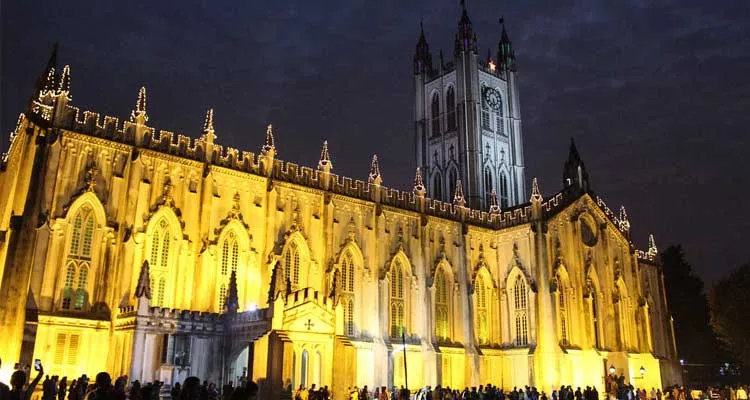
Feast Day - 29th June
Annual Feast Day of Saint Paul and Saint Peter held on 29th June.
Mass Time
Weekdays
Sundays
Church Visiting Time
Contact Info
Cathedral Road, Maidan,
Kolkata, West Bengal – 700071, India
Phone No.
Tel : +33 2223 0127
Accommodations
How to reach the Cathedral
Kolkata is very easily accessible from all major cities. Commuting within the city is also hassle free with top car rental companies in Kolkata. There are several forms of transport available to reach St. Paul’s Cathedral.
By Air: Nearest Airport – Netaji Subhash Chandra Bose International Airport
One can hire a prepaid taxi (yellow taxis) or rent a cab (Ola, Uber, etc.) to reach the cathedral.
By Train: Nearest Railway Station – Howrah junction
There is no dearth of yellow taxis, and cabs (ola, uber, etc) from Kolkata railway station parking that would directly take visitors to the cathedral.
By Bus: All local buses ply to this area. One may board any bus that goes towards Park Street or Dharmatala and get down at Park Street or Exide.
Nearest Metro Station: Maidan Metro Station is the nearest metro station.

